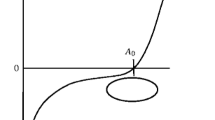Abstract
Most of the elastic tubes found in the mammalian body will collapse from a distended circular cross section and when collapsed may undergo flow-induced oscillations. A mathematical model describing fluid flow in a collapsible tube is analysed using the software package AUTO-86. AUTO-86 is used for continuation and bifurcation problems in systems of non-linear ordinary differential equations. The model is a third-order lumped-parameter type and is based on the classical “Starling resistor”; it describes the unsteady flow behaviour and, in particular, the experimentally observed self-excited oscillations, in a way which is simple enough to give physical understanding, yet still firmly based on fluid mechanical principles. Some of the bifurcation types found in this model bear close resemblance to the types suggested by experimental observations of self-excited oscillations in collapsible tubes; they thus shed some light on the various topological changes which occur in practice, particularly in view of the fact that some of the points found numerically are diffcult to achieve experimentally, while the existence of others can only be inferred indirectly and uncertainly from experiment.
Similar content being viewed by others
References
Abraham, R. H. and C. D. Shaw, 1984.Dynamics—The Geometry of Behaviour. Part Two: Chaotic Behaviour. Santa Cruz. California: Aerial Press.
Bertram, C. D. and T. J. Pedley. 1982. A mathematical model of unsteady collapsible tube behaviour.J. Biomech. 15, 39–50.
Bertram, C. D. and T. J. Pedley. 1983. Steady and unsteady separation in an approximately two-dimensional indented channel.J. Fluid Mech. 130, 315–345.
Bertram, C. D., C. J. Raymond and T. J. Pedley. 1990. Mapping of instabilities for flow through collapsed tubes of differing length.J. Fluids and Structures 4, 125–153.
Bertram, C. D., C. J. Raymond and T. J. Pedley. 1991. Application of nonlinear dynamics concepts to the analysis of self-excited oscillations of a collapsible tube conveying a fluid.J. Fluids and Structures 5, 391–426.
Cancelli, C. and T. J. Pedley. 1985. A separated-flow model for collapsible tube oscillations.J. Fluid Mech. 157, 375–404.
Conrad, W. A. 1969. Pressure-flow relationships in collapsible tubes.IEEE Trans. Biomed. Engng. 16, 284–295.
Doedel, E. and J. P. Kernévez. 1986. AUTO: Software for continuation and bifurcation problems in ordinary differential equations. Applied Mathematics Report, California Institute of Technology.
Grotberg, J. B. and N. Gavriely. 1989. Flutter in collapsible tubes: a theoretical model of wheezes.J. Appl. Physiol. 66, 2262–2273.
Guckenheimer, J. and P. Holmes. 1986.Nonlinear Oscillations, Dynamical Systems and Bifurcations of Vector Fields. New York: Springer-Verlag.
Guyton, A. C. 1986.A Textbook of Medical Physiology. Philadelphia: Saunders.
Jensen, O. E. 1990. Instabilities of flow in a collapsed tube. Appendix A: hysteresis of the steady solutions.J.Fluid. Mech. 220, 623–659.
Kamm, R. D. and T. J. Pedley. 1989. Flow in collapsible tubes: a brief review.ASME J. Biomech. Engng. 111, 177–179.
King, A. S. and J. McLelland. 1984. BIRDS their structure and function. London: Ballière Tindall and Cox.
Knowlton, F. P. and E. H. Starling. 1912. The influence of variations in temperature and blood-pressure on the performance of the isolated mammalian heart.J. Physiol. 44, 206–219.
Matsuzaki, Y. 1986. Self-excited oscillation of a collapsible tube conveying a flow. InFrontiers in Biomechanics. G. W. Schmid-Schonbein, S. L-Y. Woo and B. W. Zweifach (Eds). New York: Springer-Verlag.
Morgan, P. and K. H. Parker. 1989. A mathematical model of flow through a collapsible tube. I. Model and steady flow results.J. Biomech. 22, 1263–1270.
Shapiro, A. H. 1977. Steady flow in collapsible tubes.ASME J. Biomech. Engng. 99, 126–147.
Thompson, J. M. T. and H. B. Stewart. 1986.Nonlinear Dynamics and Chaos: Geometrical Methods for Engineers and Scientists. Chichester: Wiley.
Ur, A. and M. Gordon. 1970. Origin of Korotkoff sounds.Am. J. Physiol. 218, 524–529.
Author information
Authors and Affiliations
Rights and permissions
About this article
Cite this article
Armitstead, J.P., Bertram, C.D. & Jensen, O.E. A study of the bifurcation behaviour of a model of flow through a collapsible tube. Bltn Mathcal Biology 58, 611–641 (1996). https://doi.org/10.1007/BF02459476
Received:
Accepted:
Issue Date:
DOI: https://doi.org/10.1007/BF02459476




